What Is Goat Milk Butter And What Does It Taste Like?
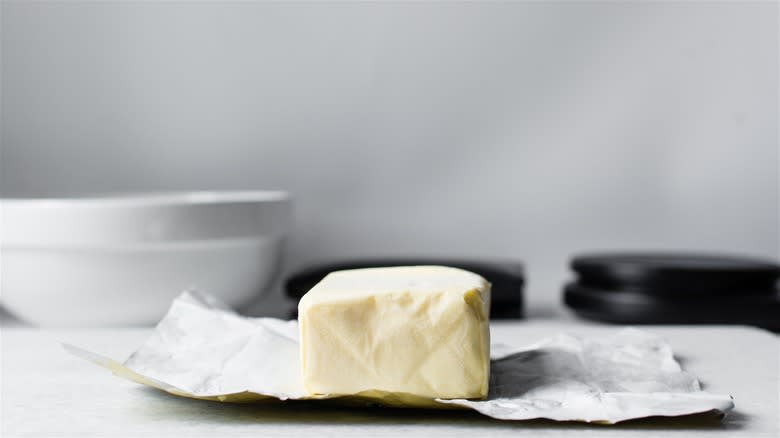
In many households, butter is about as fundamental a kitchen staple as salt and pepper, and even more versatile. It tastes just as delicious in cinnamon rolls as it does on broccoli, and is a crucial ingredient in everything from creamy pasta sauces to dense chocolate brownies. You'd be hard-pressed to find a more hard-working ingredient, whether it's creating the lamination in a pie crust, or bringing out the succulent flavors in a pan-seared steak. There is no substitute to rival its rich, mildly sweet flavor, no matter how many plant-based spreads or animal fats come onto the market, and it turns out that it might have some significant health benefits of butter, too.
Most of us think of butter as a product derived exclusively from cow's milk, but in the ever-expanding culinary world, there are new butter products to challenge this limited view. Chief among them is goat milk butter, a product with a unique set of strengths. Derived from goat milk, it has a distinct flavor, appearance, and nutritional profile to cow milk butter, and is just as useful in the kitchen. Here's everything you need to know about this up-and-coming dairy product and why you might want to add it to your shopping list.
Read more: 12 Little-Known Facts About Salt
It's Made In A Similar Way To Other Types Of Butter
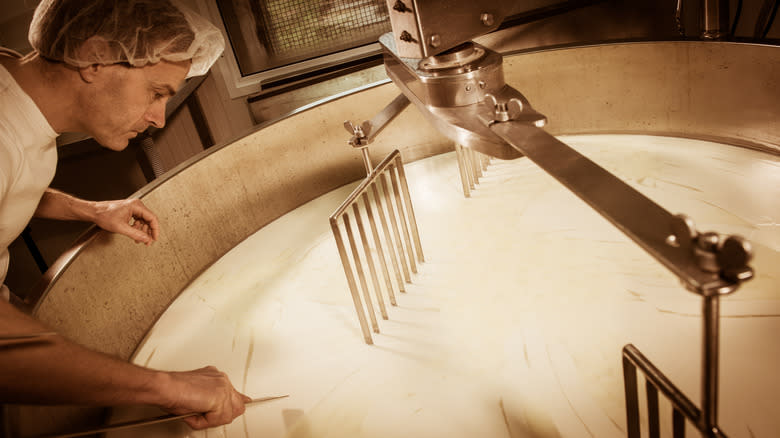
The manufacturing process of goat milk butter is similar to that of cow milk butter. The milk is harvested and sent to a dairy to be separated into cream and skim milk. This process is more difficult with goat milk than cow milk because the fat molecules in goat milk are much smaller and less inclined to rise to the top of the liquid. It's one of the things that makes it challenging for people to make goat milk butter at home, but in an industrial facility, it poses less of a hurdle.
Once the cream has been separated, it is pasteurized to kill any bacteria that might be lurking there and left to mature for about 24 hours (if it's left too long it will turn into cheese). Finally, it is churned. Traditionally, butter churns were barrel-shaped wooden vessels with long paddles fitted inside. Someone would stand over the churner and move the paddles by hand, with the continuous motion causing the cream to eventually separate into butter and buttermilk. Thanks to mechanization, humans no longer have to sacrifice their time and muscle for this process, which is instead carried out by mechanized steel churns. Similarly to its separation into cream and skim milk, goat cream requires more churning than cow cream, but the result is similar in appearance and texture.
People Have Probably Been Making It For Thousands Of Years

The history of butter is closely intertwined with the history of agriculture. Goats were domesticated sometime around 10,000 B.C. in what is now Iran, making them the oldest known domesticated animal aside from dogs. The origins of butter left less of an archaeological footprint, but historians believe it may have been created by accident when a nomad tied a bag of milk to his horse and found that it separated into a delicious, solid substance after a day of bumpy travel. By 1,000 B.C., people in India were using clarified butter, known as ghee, as an offering to the god Krishna, whose divine intellect was said to be fueled by the ingredient.
Given that goats were domesticated earlier than cows, it's surprising that store-bought butter is almost exclusively cow-based. Archaeologists believe that goat's milk has been used to feed babies since 3,000 B.C., suggesting that it was a crucial ingredient for a large portion of human civilization. Why humans turned to cow's milk likely boils down to two things. First, cows produce significantly more milk than goats. According to the U.S.D.A., a dairy goat produces around 7 pounds of milk per day. Cows can produce more than 100 pounds (per Slate). The second reason has to do with adaptability. Like dogs, cows were quickly bred to be docile around humans, whereas goats, like cats, remain more similar to their ancestors and are less tolerant of human handling.
It Has A Distinctive Flavor
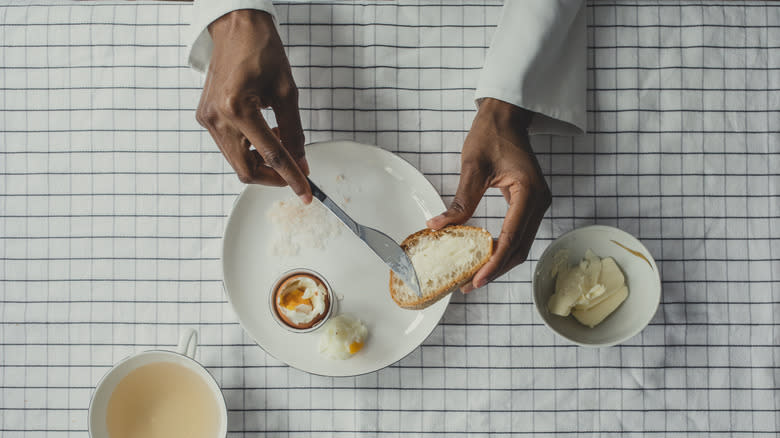
If you've ever tried goat milk, you'll know it has a stronger flavor than cow milk. Although some products taste sweet and mild, others can have a light goaty flavor that, strangely, is not as unpleasant as it sounds for many people. Goat milk butter falls on the milder side of the spectrum but is still more flavorful than cow milk butter. There's a bit of tanginess, but it isn't strong enough to deter even someone who prefers the neutral taste of cow milk butter.
What sets goat milk butter apart is its airy creaminess. The smaller fat globules make it light and rich at the same time, which, although not related to flavor, greatly influences the eating experience. If you really dislike the taste of goat cheese, you may be pleasantly surprised by the mildness of goat butter. However, there is a faint, earthy tang that you may find unappetizing.
It Can Be Used In A Wide Range Of Recipes
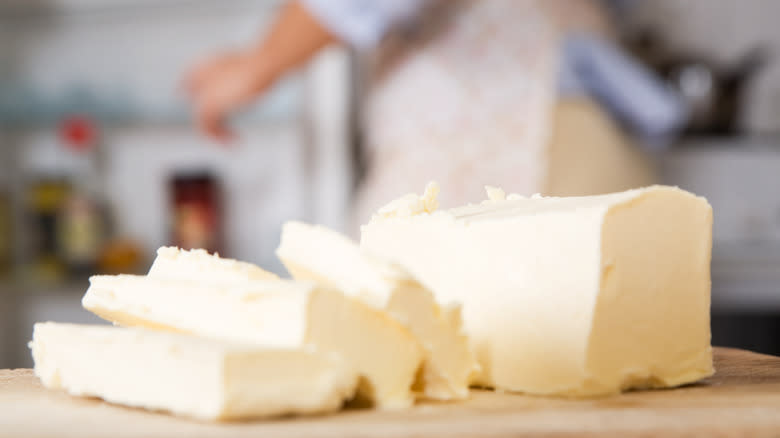
Choosing goat milk butter isn't just a question of flavor. It acts differently when added to recipes than cow milk butter. For one thing, it's lighter than its cow-based counterpart, providing a snow-white color that is perfect for buttercream frosting. For another, its low melting point has a profound effect on baked goods. Because it softens more readily, it coats the proteins in the flour more fully than cow milk butter, sealing them off from moisture and thereby preventing too much gluten development. As a result, cookies and cakes made with goat milk butter are more tender. That said, you should probably steer clear of it if you want a recipe that has structure and springiness, but for shortbread and soft, tender cakes, goat butter is a champion ingredient.
There are many other ways to incorporate goat butter into your cooking. In most cases, it is an easy swap for cow milk butter, whether you're slathering it on toast or sautéing veggies. Because of its low melting point, however, it may be more difficult to work with in pastry recipes, which require the fat to be kept at a very cold temperature even during handling to achieve the perfect lamination.
It Has A Low Melting Point
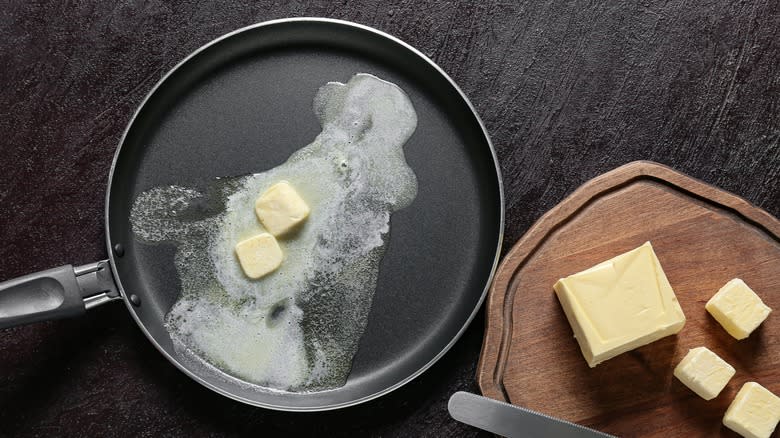
Perhaps the biggest difference between goat milk butter and cow milk butter is its melting point. While butter derived from cow milk melts at 92.6 F, butter derived from goat milk melts at 85 F (per Southern Living). The reason for this is its fat composition. While both types of butter contain a similar percentage of fat — around 82% for European styles — goat milk butter is composed of smaller fat particles that melt more quickly than the larger ones in cow milk butter. This makes goat milk butter an ideal ingredient to keep on hand for toast because it spreads more easily than standard butter.
The soft consistency is also a boon for bakers who are usually running behind schedule. It can take hours for cow milk butter to soften at room temperature when you're preparing to make cake or cookies, but goat milk butter will soften in no time. If you live in a hot climate, however, you'll have to be extra careful. While you may be able to get away with leaving cow milk butter on the counter 24/7 without it turning into a puddle, goat milk butter is much less forgiving.
It Has A Different Color Than Cow Milk Butter
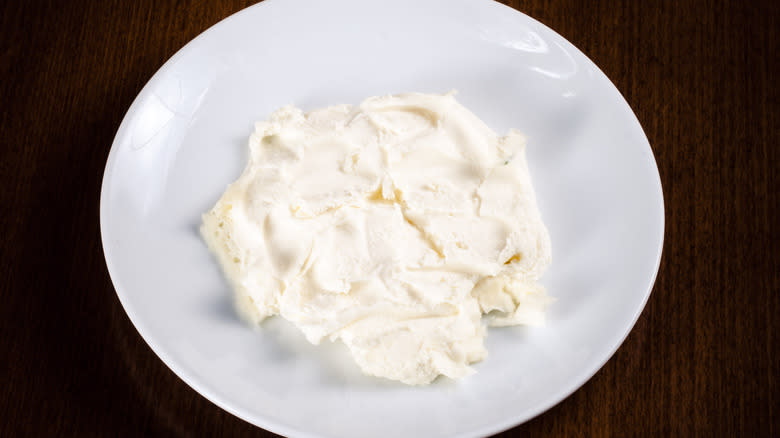
Cow milk butter often has a faintly golden tinge to it, which is the result of its concentration of beta-carotene, a pigment that provides a distinctive orange color to carrots, sweet potatoes, and other vegetables. Grass contains beta-carotene, and when cows ingest it, some of the pigment is passed into their milk. This is why cows that are fed grass produce yellow butter whereas cows fed grain or even hay produce whitish butter.
Beta-carotene is a precursor to vitamin A, a colorless nutrient that is essential for vision, the functioning of the immune system, reproduction, and healthy lungs, heart, and other organs (per the National Institutes of Health). When humans consume beta-carotene, such as in cow milk butter, some of it is converted to vitamin A. Unlike cows, however, goats metabolize beta-carotene fairly quickly, meaning that their milk has lots of vitamin A and very little beta-carotene. As a result, goat butter is usually snow white, though some manufacturers add carotene to make it look more like cow milk butter.
It May Be A Good Option For Those With Dairy Allergies

If you're someone who struggles to eat dairy, you're not alone. The National Institutes of Health estimates that 68% of people worldwide have trouble digesting lactose, a condition called lactose malabsorption. While most infants can tolerate lactose, many of us slowly lose our tolerance for it as we age. You might have heard that goat milk is safe to drink for people with dairy allergies. While this is an oversimplification that does not apply to everyone, some people indeed tolerate goat milk better than cow milk.
Goat milk contains almost as much lactose as cow milk (about 1% less per Michigan State University), but some people find it easier to digest than cow milk, especially those whose issues with lactose are mild. If you're able to consume cheese without discomfort but milk doesn't sit well, you may find that goat milk products do not cause problems.
There are multiple reasons why goat milk produces fewer negative reactions in people than cow milk. One is that its fat globules are smaller and therefore require less work for your digestive system. Another is that goat milk contains a different type of casein than cow's milk, a protein to which some people have a severe allergy. Although it is not accurate to say that goat milk products are safe for people with cow milk allergies, it is safe to say that they may be a safe option for some.
It Can Be Expensive And Hard To Find

Around the world, cows have a monopoly on the butter market. Most people automatically associate the creamy spread with cow milk and have little reason to branch out. Because of this, goat milk is in low demand and can be difficult to find. And if you do manage to find it, likely at a high-end health food store, it will probably be more expensive than even the fanciest cow milk butter. To understand why, all you have to do is look at the numbers. According to Cypress Grove Cheese, there were 9.4 million milk cows in the U.S. in 2020, compared to only 420,000 milk goats. This discrepancy is compounded by the fact that a goat can only produce 10% of the milk that a cow can. The raw material for producing goat milk butter is therefore scarcer and more expensive than cow milk butter.
Added to this is the fact that most manufacturers of goat milk butter are appealing to a high-end market where they are competing with premium, European-style products. Many goat milk butters are made using traditional, small-scale production methods that take extra time and careful sourcing, which increases the value of the products. As a result, a 250-gram block of goat milk butter could set you back $10 or more, costing even more than high-end European-style cow milk butter.
You Can Make It At Home
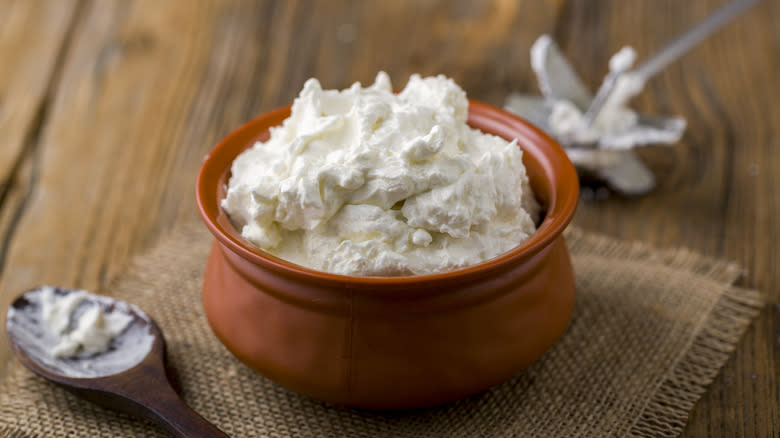
You might have made butter in elementary school as part of an introductory science class. All you have to do is fill a jar with cream, add a marble to it, and shake. It will make your arm sore, but after a while, you'll have perfectly separated butter and buttermilk. Goat milk butter can also be made at home, but it's more challenging. For one thing, cow's milk naturally separates into cream. If you've ever purchased whole milk or whole milk yogurt and discovered a thick layer of cream on the top, this is the stuff that you skim off and start shaking to produce butter. But goat milk is homogenized, meaning that its fat is integrated with the milk and will not separate as readily. You'll have to let the milk sit in the fridge for several days to achieve any separation, and even then, it will yield far less cream than cow milk.
Another complication is the size of the fat molecules. Because they are smaller, they form smaller butter grains when churned, and you'll have to shake that jar for quite a bit longer than you would for cow milk butter. In fact, you might have to give up on that method altogether and use a blender. Despite these hurdles, however, making goat milk butter at home is doable, especially if you go into it with plenty of patience.
It May Have A Shorter Shelf-Life Than Cow Milk Butter
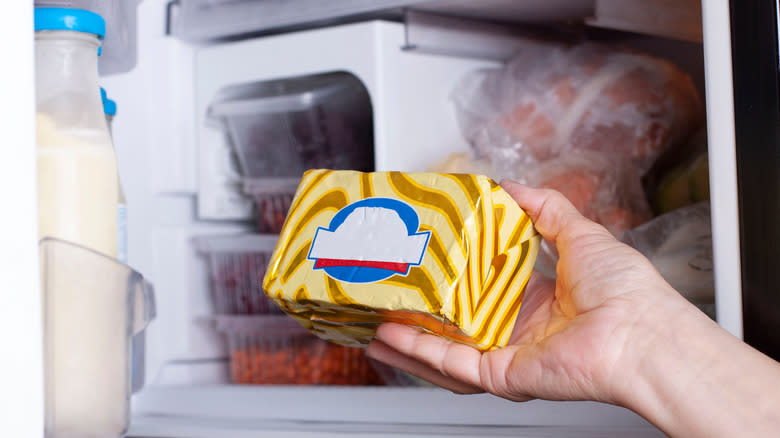
Butter isn't one of those ingredients that you can eat all in one sitting. It's more like a condiment that sits on the shelf to be picked away at for several weeks. Although many cow milk butters on the market do not contain preservatives aside from the pasteurization process, they may have longer shelf lives than goat milk butters. In contrast to the general rule of thumb that store-bought cow milk butter can last for several months in the refrigerator or up to a year in the freezer, goat milk butter should be consumed within a week of thawing, according to Delamere Dairy, one of the largest producers of goat milk products. Whether you're using cow milk butter or goat milk butter, however, products with salt will keep longer than unsalted products because salt is a natural preservative.
Another consideration is where you've sourced your ingredients. If you're using raw goat milk, which you may well be if you've purchased it at a farmer's market or received it from a friend with goats, the resulting butter will have a much shorter shelf life unless you pasteurize the cream yourself.
It Has Applications Outside Of Cooking

Goat milk products are having a moment in the spotlight right now, and one of the places where this is most evident is the body and skincare sector. Countless products on the market are touting goat milk's magical powers, from lotions and moisturizers to soap and lip butter. According to brands that incorporate goat milk into their products, it is an ideal ingredient for skincare for several reasons, most notably its luscious fat molecules. It also has lactic acid, which can act as a natural exfoliant.
Some brands focusing on all-natural skin and body care also argue that, because goat milk has a similar pH balance to human skin, it is a gentler and more absorbable ingredient. According to a study in Frontiers in Immunology, goat milk also has anti-inflammatory properties, which some skincare companies tout as an added benefit, especially for people suffering from rashes, rosacea, and other skin conditions based on inflammation.
It Has More Health Benefits Than Cow Milk Butter

Aside from its anti-inflammatory properties and digestibility, goat milk butter has other health benefits that make it a more favorable option than cow milk butter. One tablespoon of Kerrygold butter, for example, carries 0% of the recommended daily value of vitamin A. In contrast, one tablespoon of Meyenberg goat milk butter contains 10% of the recommended daily value thanks to the fact that goats metabolize beta-carotene into vitamin A more easily than cows.
When comparing whole goat milk with whole cow milk, both products have a similar number of calories and levels of protein and saturated fat. They even contain similar amounts of cholesterol. According to a study by the University of Granada, goat milk may provide one key function that actually helps lower cholesterol and therefore the risk of heart disease as well. The research, which was conducted on rats, aimed to compare the effects of cow milk and goat milk. It found that when rats consumed goat milk, it led to an increase in the amount of cholesterol used to produce bile, a substance necessary for fat digestion. As a result of this increased production of bile, the level of harmful cholesterol in the rats' blood, which is associated with heart disease, decreased. Though more research is necessary to discover if there are similar effects on humans, the study indicates that goat milk products may be a healthier option than cow milk products, particularly for people with high cholesterol.
Read the original article on Mashed.

